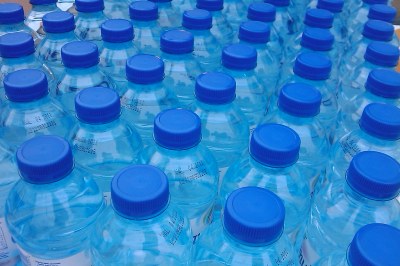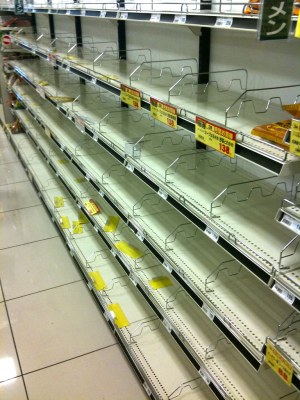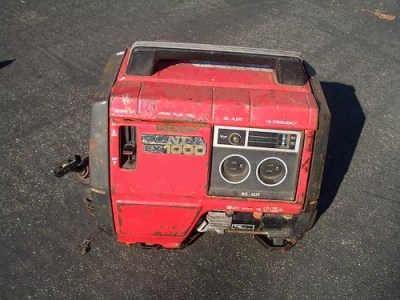Ask Hackaday: How Do You Prepare?

Last month, large parts of the southern United States experienced their coldest temperatures since the 1899 Blizzard. Some of us set new all-time lows, and I was right in the middle of the middle of it here in Southwestern Oklahoma. Since many houses in Texas and Oklahoma are heated with electricity, the power grids struggled to keep up with the demand. Cities in Oklahoma experienced some short-term rolling blackouts and large patches of the Texas grid were without power for several days. No juice, no heat.
In places where the power was out for an extended period of time, the water supply was potentially contaminated, and a boil order was in effect. Of course, this only works when the gas and power are on. In some places, the store shelves were empty, a result of panic buying combined with perishables spoiling without the power to keep them cold. For some, food and drinkable water was temporarily hard to come by.
There have been other problems, too. Houses in the south aren’t built for the extreme cold, and many have experienced frozen pipes, temporarily shutting off their water supply. In some cases, those frozen pipes break open, flooding the house once the water starts flowing again. For instance, here’s an eye-witness account of the carnage from The 8-bit Guy, who lives at ground zero in the DFW area.
To put it simply, it was bad. It could have been worse — power was only out for a few days, not the worst case scenario of months without power. Even so, it was bad enough, and dozens have died. The experience has many of us thinking seriously about what we can do to be better prepared for the *next* unexpected event that threatens our households.
I’ll tell you what I did that seemed to work, what I’ve seen others do, and then you all can tell us what preparation make sense for where you live. I’m also pulling information from the official FEMA recommendations (PDF). The key here is to make preparations ahead of time, when there is no emergency. No only does this save your skin, it also keeps you from being part of the problem, out panic buying toilet paper, milk, and bread.
Thinking Through Your Necessities — Water

The rule of thumb is a gallon of water per person per day. A family of four, for a week, would go through 28 gallons of water, and that might be more than you think. Bottled water is great for something easy to grab and go, but at pints to a gallon, we’re talking over 200 bottles of water. Alternatively, you can buy gallon jugs of water, though those get expensive and take up a lot of room as well.
But this is Hackaday, we prefer a clever, off-the-beaten-path approach. My local home improvement stores sell branded 5-gallon plastic buckets that happen to be food-grade rated. At under four dollars a piece, you can set aside a decent cache of drinkable water for not very much.
If you fill water containers yourself, do keep in mind the fact that water will not stay potable indefinitely. The big problem is algae growth. The key here is to keep air and light out of your water. My buckets of water are well sealed, and tucked away in the corner of the garage, well out of the sunshine. It’s a good idea to refresh the water periodically, though how often this should happen is subject for debate, and taste. If you’re using your city’s chlorinated water supply, and keeping it stored well, water should keep for years, but to be safe you might refresh it once a year. The important thing is to think about it now, rather than filling your bathtub in panic after a water rationing order has been issued.
Let Them Eat Cake

Food is less immediately pressing than water, but if your local grocery store couldn’t receive shipments for a couple weeks, would you have enough food to comfortably get by? Don’t forget, a refrigerator or freezer full of food isn’t very useful if the power is out, and you can’t keep it cold. Shelf stable goods are the way to go. Canned beans and vegetables are particularly good choices, and it’s hard to go wrong with a five-pound bag of rice. The key here is to rotate your supply. When you buy a can of green beans, put it at the back of your pantry, and pull the older cans to the front. You don’t want to finally need to eat your emergency supply, only to find that it was all best by 1985.
There are companies that make food packs specifically for emergency use. They’re usually dehydrated foods, and often all boxed up for easy grab-and-go. If you have the budget for it, they’re a great part of your kit. Many of these will have extra-long shelf life, 25 years in some cases. But of course, you’ll need water.
It’s also worth having a few camp-style cooking tools. A cast iron pan and a campfire coffee pot or percolator can help prepare food or boil water that’s suspect. Make sure you have a can opener with your cans. A backpack full of canned goods isn’t useful without a way to open them. A quick tip from my wife, a few disposable plates and silverware is handy if you don’t have water to spare for washing dishes.
Shelter And All It Implies
Shelter can mean different things, depending on whether you’re in a cold snap like I was last week, or in a blazing hot summer. For now, we’ll talk about heat, and then electricity.
When it comes to makeshift heating solutions, be careful. It appears that more of the deaths in Texas were from either house fires or carbon monoxide poisoning than from the cold itself. In one case, a family brought a gas grill in from outside in an attempt to stay warm. Gasoline, natural gas, and propane combustion can all produce carbon monoxide. If you’re going to use a running vehicle to generate heat or power, pull it well away from your house. The same goes for a generator — make sure it is well away from the house, and downwind if possible. Propane and natural gas heaters that are rated for indoor use have been carefully engineered to produce minimal amounts of carbon monoxide, and are safe for indoor use. Even then, it’s very strongly recommended to have a carbon monoxide detector in working order. Carbon monoxide will kill in your sleep, with no warning. Get a detector, and keep batteries in it. Make sure it’s working.
There are some great options for keeping yourself warm. To really cover your bases, though, you need to diversify. We used an oil-filled electric radiator to keep one of the bedrooms a bit warmer through the cold nights. It uses only electricity, and is considered one of the safer electric heaters. If your house is gas heated like ours, this could be a life-saver. Another option is one of the portable propane heaters, like a “Heat Buddy”. These often run on camping propane canisters, which are easy enough to keep on hand, and don’t really ever go bad. Heaters are probably hard to purchase right now, as everyone needs one. Pick up what you need this summer, and be prepared for the next time it turns into a frozen wasteland.

If you have a fireplace or wood stove, that’s great. There are some potential problems there, too, but that can keep you warm in an emergency. If it hasn’t been inspected and cleaned recently, find a chimney-sweep to take a look at it. A dirty chimney, if it’s full of creosote, can catch on fire and burn your house down. To avoid creosote build-up, make sure you’re burning well-seasoned wood. Try to have some wood on hand, just in case you really need a fire. Do not use an outdoor fire pit indoors, as this will almost certainly burn your house down. A wood stove can easily do the same, if flammable materials are too close to it while it’s running.
The last tip I have for heating might be very regional, but it’s still something to check for. If you have a natural gas central heating system, go check for a wall plug where the unit is plugged in. That heater only needs enough power to run the electronics and turn the blower fan. If you have gas but not power, all you need to do is get power to that plug, and the heater will work. We’ll chat about how you might do that shortly.
Electricity
Let’s talk about electricity. The gold standard here is a large generator, and a transfer switch — a large switch that only allows you to connect the generator to the house power if the connection to the power company has been disconnected. Many a lineman have been injured or killed by a line that was supposed to be off, but it was in fact energized by a generator in someone’s house. Don’t be that someone.
If a full transfer switch is too expensive, look into a bolt-on interlock kit. (You can even make your own!). This is a bit of a hack, but it physically prevents your mains power and your generator circuit from being engaged at the same time. In a life-or-death situation, you can energize your house though a dryer plug and a “suicide cable”, but make absolutely sure that you turn off the main breaker first.

If you have a generator, then make sure that you stay on top of the maintenance issues involved. Pull it out from time to time and make sure it starts and runs. Keep some gas on hand, but rotate that gas through your mower or car, to keep it from going bad. Some people swear by the idea that ethanol free gas stores better, and is better for small engines. And for goodness sake, don’t run a generator in your garage. Just like your car, the engine is putting out loads of carbon monoxide, and that will kill you.
Lithium ion batteries have exploded (hah!) in popularity in the last few years, and a couple of must-have gadgets are now available for purchase. The first is the lithium-ion jump starter. It’s incredible that such a tiny brick can jump start a large engine, but these units also allow phone charging, and usually have an emergency light to boot. If that’s not enough to meet your power needs, consider its big brother, the power station. These are essentially a lithium ion with a power inverter, giving you mains power for a limited time. Some of the nicer models can even charge off a solar panel, making this a perfect way to keep power flowing in a pinch. At something like a dollar per watt, the convenience does come at a premium.
Jenny did a great job covering power outages a few years ago, so check that out too.
Community
The most important step to being prepared for disaster isn’t a generator, barrels of water, or a pantry full of food. Believe it or not, it’s knowing your neighbors. When we moved into our current house, our neighbor came over and explained that she had a storm shelter in her back yard. If there was ever a tornado, we didn’t even need to ask, we could just dash over and jump in. When we received the notice that power might go off during the cold last week, I contacted a couple people who live nearby, and told them to come over right away if power went out.
Is there a nurse in your neighborhood? She might be the one to stitch you up if you’re hurt and can’t get to an ER. In the video embedded above, David came home to a flooded house, and had help from a bunch of neighbors to get everything taken care of. Is there someone elderly close by that might struggle in an emergency? Plan to check up and help out as needed.
You have space for a generator, but can’t afford one? You might ask your neighbors to help pay for it with their next tax returns, and have a plan to power up their furnaces in a power outage. The ham down the street with a radio antenna — maybe that’s you — is the most likely to be able to get a message out when other communication links are down.
One more related thought: keep a bit of cash on hand. If the power is out all over town, then ATMs probably won’t work, and neither will a credit card. You might be able to find something you need for sale, but not be able to get to your savings to purchase it. A handful of hard currency squirreled away somewhere might just get you out of a jam.
It Never Happens Here
Finally, the attitude that is the most dangerous: It never happens here. Texas never gets that cold, right? But freak events are dangerous just exactly because they’re unexpected. It’s hard to know what the next disaster will be, but it’s coming. A bit of preparation now can make a world of difference when you’re put to it, and it’s far too late to prepare once disaster has knocked on your door.
There’s more to be said about preparation. We’ve pretty much only covered how to stay alive at home. For a primer on being ready to go at a moment’s notice, read Dan’s take on the digital bugout bag.
Now, I’ve laid out some basic universal considerations, and then given some advice that makes sense in my part of the world. Sound off, let us know what makes sense where you live. Did I forget something important, let us know!
Post a Comment